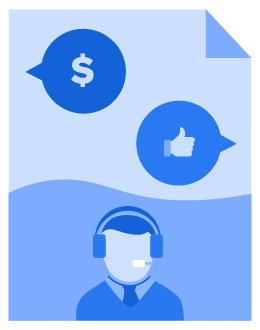When it comes to B2B appointment setting, most prospects on the other end of the phone either haven’t heard of your company or haven’t recognized any need for a solution like the one you sell. In order to set a sales meeting through cold calling efforts, you need a strategic pitch to warm up those cold prospects.
Appointment setting pitches are not one size fits all. Instead of a strict script, you need a flexible guide for your pitch that can be tailored to individual prospects.
Though the pitch may change with each cold call you make, there are 4 main phases to every prospecting conversation:
01. Introduction
02. Pitch
03. Close
04. Rebuttal
The tips and tactics you’ll find below are straight from our own sales playbook! Keep reading to learn how we’re able to navigate each phase of the prospecting conversation and set more sales appointments through cold calling.
How to start
a sales conversation
From the start of the call, it’s important to humanize yourself. You don’t want to sound like you’re reciting a pitch that’s been rehearsed and memorized. Start the conversation off confidently. Speak loud and clear. Smile while you speak with prospects to ensure you sound happy, energetic, and relaxed.
One of our favorite tactics for the introduction of a prospecting conversation is called a pattern interrupt. Some examples include:
“Do you have 20 seconds for me?”
“I realize this call is unexpected, so I’ll keep this quick.”
“I wanted to take 2 minutes to chat, and if I go over, you can start billing me. Sound fair?”
A pattern interrupt is an unexpected phrase or question that catches the buyer off guard. It’s a way to stand out to prospects and avoid sounding like a predictable salesperson.
However, you should be careful about what kind of pattern interrupt you use, what it implies, and where it might take the conversation.
For instance, asking “Did I catch you at a bad time” can make an SDR 40% less likely to book a sales meeting, according to Gong’s analysis of 90,380 sales calls. The analysis also found that asking “How are you?” can make you 3.4x more likely to set the appointment.
With marketing leads and other warm leads, you should try to leverage past activity to warm up the conversation. Mention a piece of content the prospect downloaded and explore their needs surrounding that topic. Or demonstrate that you remember their needs from the last time you spoke and let them know that you’re following up to help them find a solution.
You should finish the introduction portion of the call with your reason for calling. SDRs who state their reason for calling see a 2.1x higher success rate on average. Be up front and let the prospect know what to expect.
“The reason I’m calling is to schedule some time to discuss how EBQ can help your salespeople win more business.”
Lastly, consider asking a discovery question to help you navigate toward setting a meeting.
“Are your salespeople currently doing their own prospecting?”
Appointment setting
elevator pitch
- Anticipating and addressing objections before they’re given
- Outlining key differentiators of your offering — what makes you special and different from your competitors?
- Leveraging relevant sound bites (predefined value statements, such as “Standard and custom reports built into your CRM at no additional cost”)
- Offering customer success stories related to the prospect’s industry and/or business needs
It’s important to do your research before reaching out to a new prospect, so you can get familiar with their company and what they do in their specific role.
This prospect research is critical since 79% of buyers say they won’t engage with salespeople who lack knowledge about their company, according to LinkedIn’s State of Sales Report. On the other hand, 93% of buyers surveyed in the report say they are more willing to engage with salespeople who provide personalized communications.
Remember to make your pitch your own! SDRs shouldn’t rely too heavily on scripts for the elevator pitch but instead use them to guide the conversation.
Speak naturally and let your genuine personality work to your advantage, rather than being the lead actor in your play and delivering a perfectly scripted line. This should be easily attainable if you’re as knowledgeable about your offering and your buyer persona as you should be.

Interested in the Best Cold Calling Scripts for Software Sales?
Our guide includes sales expert’s insights and best practices. Free for anyone who’s ready to create high-converting scripts.
Closing
on the sales meeting
The purpose of a prospecting conversation is not to pitch your product — it’s to set the sales meeting. By this point, you’ve provided insight into how your offering can deliver value. And, if done effectively, you’ve piqued their interest. You need to maintain that momentum in order to set the appointment.
Use strong sales language, such as asking “when” instead of “if.” Omit submissive language, such as “just,” “hopefully,” “maybe,” and “might.”
“Next Tuesday at 9 a.m. work for you?”
Another tip that helps our reps is to try asking the prospect, “Are you in front of your calendar?” instead of asking if they’d like to meet. Confidence is key for the closing portion of the call. When you appear confident to prospects, they feel more confident in your solution and its capabilities.
When appropriate, use what we call collaborative suggestion, language that emphasizes you and your prospect working together to find a good solution to their needs.
“Why don’t we do this…”
“Let’s put some time on the calendar for next Wednesday.”
In fact, Chorus analyzed over 500,000 sales calls and found that top performing sales professionals were 10x more likely to use collaborative language like “we,” “us,” and “our,” versus wording like “I,” “me,” and “your.”
Most importantly, the only way to set a sales appointment is to ask. You don’t get what you don’t ask for.
It seems obvious enough, but objections can be discouraging for SDRs. The final phase of a prospecting conversation involves knowing how to respond to those objections.
Sales rebuttals for
objection handling
- Which competitive solution they use or have used
- Which specific pain points they’re experiencing
- When their expiration date or solution review is

Download our list of 28 Discovery Call Questions
Get the most out of your discovery call questions with our tips, best practices, and practical examples you can use in your own sales development outreach.
- Let them know that you understand how they feel.
- Inform them you’ve encountered other customers who felt that way initially.
- Tell them that those customers ultimately found a positive outcome after purchasing.
This technique makes use of a customer success story to address the prospect’s concern and dismiss it. An example of the Feel, Felt, Found method in action might sound like:
“I understand you feel that your internal SDR team generates a sufficient number of sales meetings. One of our clients who previously had in-house SDRs felt that way initially. But after a few months working with our appointment setting department, they found a 6x increase in appointment setting productivity.”
Feel, felt, found helps fill the gap between the prospect’s uncertainty and the positive outcome you say your solution can provide. If you can identify a “found” statement that resonates with the specific prospect you’re speaking to, you’ll have a better chance at convincing them to take the sales meeting.
A good SDR will embody professional persistence. Don’t stop pushing against their objection until you hear “no” multiple times. And if your rebuttals just aren’t sticking, make sure to set a follow up date.
Don’t lose your prospecting momentum or get too discouraged if you can’t get past the “no” this time, as you will have created a warmer prospect for your next follow up.
So, how do you get
a sales meeting?
Getting your prospects to agree to a meeting requires a tailored pitch, which can only be achieved through research, preparation, and effective discovery. Good salespeople maintain a natural conversation when speaking with buyers and are genuine when discussing how their solution solves customer pains.
Know how to summarize the value of your offering, address objections before they’re mentioned, and follow the advice outlined above — and you should be on your way to better prospecting conversations.



